When skis float on endless stashes of pow and countless lifts beckon us further and further into the mountains, these are the resort days of our dreams-an experience only the largest ski resorts on earth can show us. For this, we’ll happily get sucked into the belly of a ski behemoth: the world of well-serviced lodges, fast lifts, and limitless terrain. But where are these fabled giants of ski-landia? The answer is a little harder to come by than you would think.
There’s something amorphous about ranking the biggest ski resorts by size. The U.S. and Canada do it by skiable acreage, while in Europe, resorts measure size based on the end-to-end length of their ski runs. But what counts toward skiable acreage and how runs are measured remain fuzzy.
Skiing can be such an exciting winter sport, and there are some of the world’s largest ski resorts one can imagine. Whether it is endless terrains, top amenities, or breathtaking views, one is sure to get what he has been looking for. Here is a comprehensive guide to the world’s largest ski resorts with practical tips and precautions while also suggesting combinations of adventure with romantic getaways near me for the perfect winter escape.
One of the most important aspects of planning a family skiing trip is choosing the right resort, and the largest ski resorts in the world are perfect for families as they provide so many activities and services that satisfy everyone who might be either a beginner or an experienced skier.
Why the Largest Ski Resorts in the World Are Perfect for Families
Planning a ski vacation for families requires the identification of a destination that best offers accessibility, entertainment, and safety for individuals of all ages. Perhaps the biggest ski resorts in the world are the best family-friendly destinations because they offer a lot of different activities and services for every member of the family, whether a beginner or a skilled skier.
Pro Tip: To optimize your time, look for resorts with dedicated “family zones” where beginners and kids can learn without the pressure of faster skiers.
1. Les 3 Vallées, France
- Total Skiable Terrain: 600 km
- Runs: 328
- Lifts: 166
- Average Snowfall: 4 meters
It is the largest connected skiing zone on earth. Its aerial views are simply overwhelming, and its villages like Courchevel and Méribel charm has made it one of the elite destinations in the world. The Les 3 Vallées, based in France, by the Alps, came onto the horizon around the mid-20th century as a haven for skiers. It was created by connecting major three valleys: Courchevel, Méribel, and Belleville, under one unifying theme-to create the world’s largest skiable territory.
Development started in 1946 with the construction of the Courchevel resort. The network was built further to include Val Thorens, the highest ski resort in Europe. The resorts were interconnected through state-of-the-art ski lifts and gondolas in the 1970s. It now boasts 600 kilometers of runs that attracts skiers from around the world.
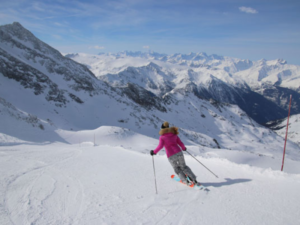
Amazement
- Peak Experience: Val Thorens is a paradise for high-altitude skiing, offering breathtaking panoramic views.
- Night Skiing: Evening slopes under floodlights provide a magical experience.
- Village Charm: Méribel’s wooden chalets and alpine vibes captivate visitors.
Pro Tips:
- Map It Out: Use a GPS ski app to navigate the vast area.
- Try Night Skiing: Val Thorens offers magical evening runs.
- Stay in Ski-in/Ski-out Chalets: Maximize your slope time with these convenient accommodations.
Precautions:
- Monitor Weather Conditions: The area can experience sudden weather changes.
- Dress in Layers: To adapt to fluctuating temperatures.
- Stay Hydrated: Cold temperatures can mask dehydration, so drink plenty of water.
2. Arlberg, Austria
- Total Skiable Terrain: 305 km
- Runs: 200+
- Lifts: 88
- Average Snowfall: 9 meters
A premier ski destination in Austria, Arlberg offers everything from picturesque beginner slopes to challenging off-piste terrains. The Arlberg region is often hailed as the “cradle of alpine skiing,” with a history dating back to 1901 when the Ski Club Arlberg was founded in St. Anton, one of the earliest alpine ski clubs in the world.
Skiing techniques, as developed here, started becoming more productive by the 1920s, and, of course, these developments were only part of what led to the Arlberg technique, the forerunner of modern skiing. Galzigbahn, the area’s first ski lift, was built in 1937. Lech, Zürs, St. Christoph, and Warth-Schröcken all eventually came together to form one of Austria’s most exceptional ski resorts.

Amazement
- Historic Runs: St. Anton features trails where alpine skiing originated.
- Après-Ski Culture: Renowned for its vibrant après-ski nightlife.
- Exclusive Atmosphere: Lech is a favorite retreat for royals and celebrities.
Pro Tips:
- Explore the Backcountry: Perfect for advanced skiers.
- Hire an Instructor: Beginners benefit greatly from world-class ski schools.
- Book Accommodations Early: Spots fill up quickly in peak seasons.
Precautions:
- Use Proper Equipment: Rent or bring gear suited to the terrain.
- Follow Off-Piste Safety Rules: Avalanche risk is real in some areas.
- Wear Sunscreen: Even in winter, the sun’s glare can cause burns.
3. Whistler Blackcomb, Canada
- Total Skiable Terrain: 8,171 acres
- Runs: 200+
- Lifts: 37
- Average Snowfall: 11.7 meters
Whistler Blackcomb, in British Columbia, is famous for its diverse slopes, vibrant village, and thrilling gondola rides.The story of Whistler Blackcomb began in 1966, when Whistler Mountain opened to attract the Winter Olympics. Blackcomb Mountain followed in 1980, quickly gaining recognition for its advanced runs and deep snow.
In 1997, the two mountains merged, creating the largest ski resort in North America. The installation of the Peak 2 Peak Gondola in 2008 set a world record for the longest and highest lift, cementing Whistler Blackcomb’s status as a global skiing icon.
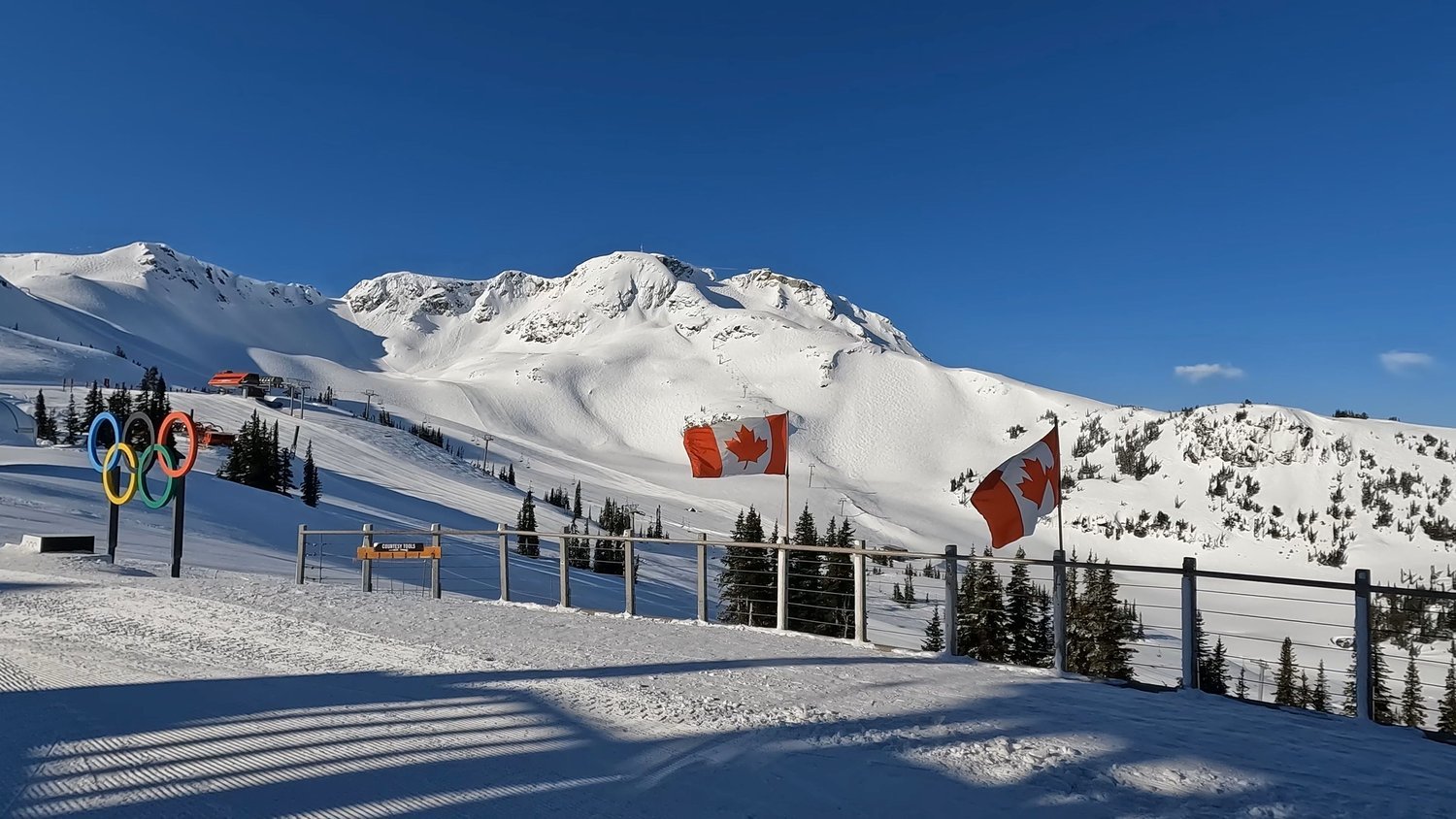
Amazement
- Peak 2 Peak Gondola: Offers stunning views and connects the two mountains.
- Diverse Terrain: Perfect for all skill levels, from beginners to experts.
- Vibrant Village Life: Whistler Village offers dining, shopping, and nightlife.
Pro Tips:
- Ride the Peak-to-Peak Gondola: It offers unbeatable views and easy mountain access.
- Arrive Early: Avoid the midday rush to get the best runs.
- Explore Whistler Village: Its après-ski scene is second to none.
Precautions:
- Beware of Fog: Visibility can drop rapidly.
- Stick to Marked Trails: Straying can be hazardous in such a vast area.
- Keep Emergency Contacts Handy: Know the ski patrol hotline.
4. Les Portes du Soleil, France/Switzerland
- Total Skiable Terrain: 580 km
- Runs: 286
- Lifts: 196
- Average Snowfall: 8 meters
Les Portes du Soleil is a cross-border paradise offering varied terrains and cultural experiences, as Les Portes du Soleil straddles the French-Swiss border. It was developed in the 1960s to connect smaller resorts into a massive ski area.
The name is also “Gates of the Sun,” ascribing to its sunny slopes. Champéry, another one of the oldest resorts, goes way back into the early 20th century. Modern lifts and ski passes ensured Les Portes du Soleil to become one of the largest ski areas in the world, easily providing access to 12 resorts across two countries.

Amazement
- The Swiss Wall: A famously steep and thrilling run.
- Cross-Border Skiing: Unique opportunity to ski between France and Switzerland.
- Cultural Blend: Experience both French and Swiss cuisines and traditions.
Pro Tips:
- Tackle the Swiss Wall: A steep, iconic run for seasoned skiers.
- Invest in Multi-Day Passes: To explore all the interconnected villages.
- Relax in Thermal Spas: End your day in one of the nearby hot springs.
Precautions:
- Carry Identification: You’ll be skiing across two countries.
- Check Lift Operating Hours: Some close earlier than others.
- Avoid Skiing Alone: Especially in challenging areas like the Swiss Wall.
5. Paradiski, France
- Total Skiable Terrain: 425 km
- Runs: 261
- Lifts: 160
- Average Snowfall: 5.5 meters
A family-friendly resort, Paradiski offers glacier skiing and easy access between its three areas via the Vanoise Express.The Paradiski area was created in 2003, linking the ski resorts of Les Arcs, La Plagne, and Peisey-Vallandry with the construction of the Vanoise Express cable car.
Already popular skiing resorts in the early days, Les Arcs, developed in 1968, and La Plagne, developed in the early 1960s, joined together to form one of the biggest interconnected ski areas in the world with glacier skiing, and terrain for all levels.
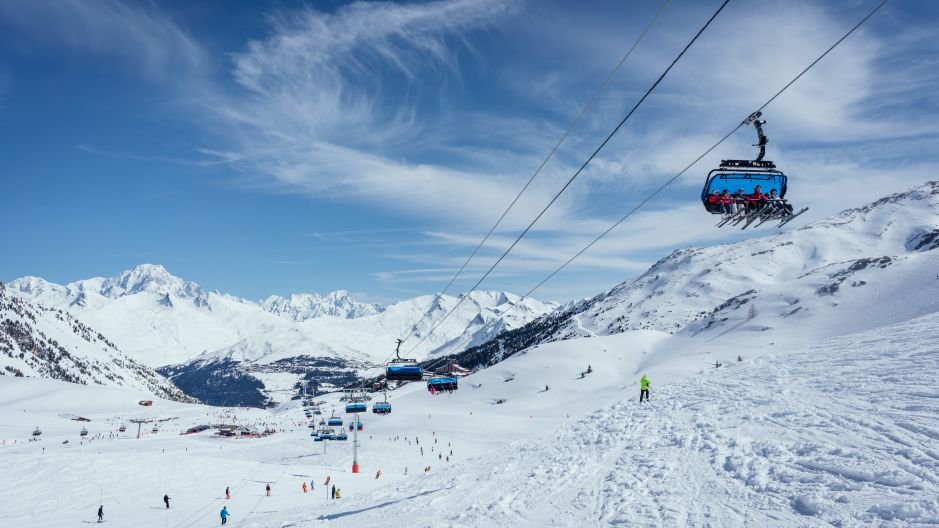
Amazement
- Vanoise Express: A double-decker cable car with panoramic views.
- Glacier Skiing: Access to year-round skiing on the Bellecôte Glacier.
- Family-Friendly: Ideal for families with beginner-friendly slopes and activities.
Pro Tips:
- Stay in Les Arcs: For the best central access.
- Opt for Family Packages: They often include lessons and rentals.
- Try Glacier Skiing: The Bellecôte Glacier offers an unparalleled experience.
Precautions:
- Prepare for Altitude: Glacier skiing can be tough on first-timers.
- Keep Kids Close: It’s a large area, so stay together as a family.
- Use Sun Protection: High altitudes mean stronger UV rays.
6. 4 Valleys, Switzerland
- Total Skiable Terrain: 412 km
- Runs: 93
- Lifts: 67
- Average Snowfall: 5.5 meters
Home to Verbier, 4 Valleys is perfect for expert skiers looking for thrilling runs and off-piste adventures. The 4 Valleys ski area, anchored by Verbier, emerged in the mid-20th century as a premier Swiss skiing destination.
Verbier began attracting skiers in the 1930s, and by the 1970s, it was connected with neighboring resorts like Nendaz, Veysonnaz, and Thyon to form a single ski area. Known for its challenging runs and vibrant culture, it has hosted numerous international skiing events.

Amazement
- Mont Fort Glacier: Offers stunning views of the Matterhorn and Mont Blanc.
- Challenging Terrain: Perfect for advanced skiers seeking off-piste adventures.
- Luxury Chalets: Verbier’s accommodations are renowned for their opulence.
Pro Tips:
- Hire a Guide: For exploring off-piste areas safely.
- Visit in Late Winter: Snow and sun are at their best.
- Indulge in Swiss Cuisine: Warm up with local delicacies like fondue.
Precautions:
- Carry Avalanche Gear: Especially for backcountry skiing.
- Check Lift Closures: Weather conditions can cause shutdowns.
- Avoid Alcohol Before Skiing: It’s tempting but dangerous.
7. Dolomiti Superski, Italy
- Total Skiable Terrain: 1,200 km
- Runs: 450
- Lifts: 450+
- Average Snowfall: 4 meters
Dolomiti Superski brings breathtaking views, legendary Italian culture, and plenty of skiing opportunities to the table. Founded in 1974, the Dolomiti Superski region in northern Italy joined 12 ski regions together under a single lift ticket.
The Dolomites are a UNESCO World Heritage Site and a favorite winter sports destination since the early 20th century. Cortina d’Ampezzo took center stage during the 1956 Winter Olympics, drawing more attention to the area.
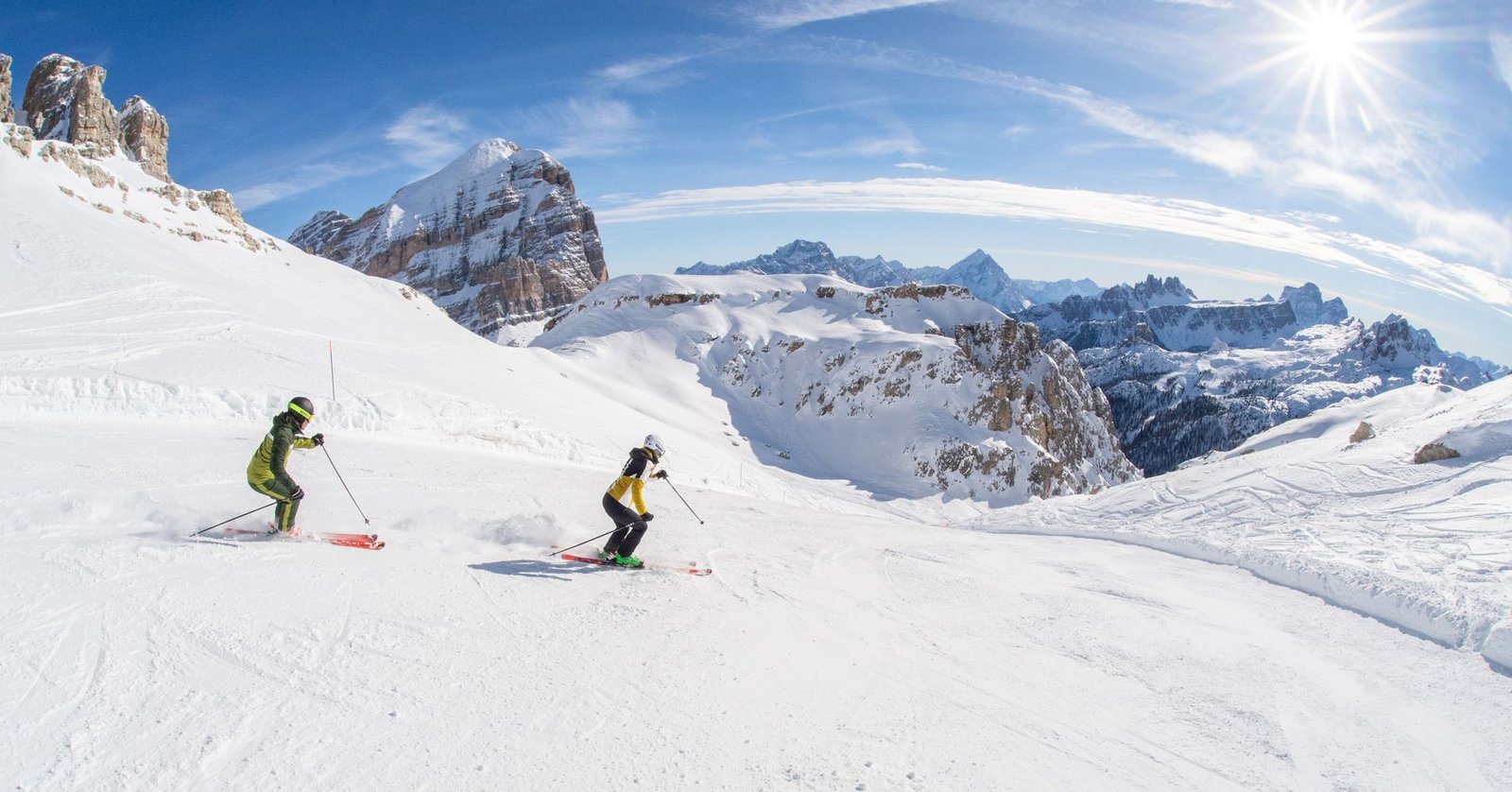
Amazement
- Sellaronda Circuit: A scenic route that lets you ski around the Dolomites.
- Italian Cuisine: Renowned for mountain huts serving authentic dishes.
- Natural Beauty: Iconic jagged peaks and sunny slopes.
Pro Tips:
- Explore the Sellaronda: A famous ski circuit with breathtaking views.
- Take a Culinary Tour: Ski between mountain huts offering regional delicacies.
- Visit in January: It’s quieter and offers pristine conditions.
Precautions:
- Plan for Crowds: Especially during holidays.
- Wear Helmets: Even experienced skiers face risks.
- Keep Snacks Handy: Runs can be long, so stay fueled.
8. Big Sky Resort, USA
- Total Skiable Terrain: 5,850 acres
- Runs: 300+
- Lifts: 38
- Average Snowfall: 10.5 meters
Due to its vast ground and minimal crowds, Big Sky Resort has become a prime destination for peaceful quietness. Big Sky Resort opened its doors in 1973 in the state of Montana as the dream of Chet Huntley, a former news anchor-turned-developer.
Today, Big Sky Resort expands into adjacent ski areas such as Moonlight Basin, creating one of the largest resorts in the United States. The resort is still a symbol of Western hospitality and adventure.
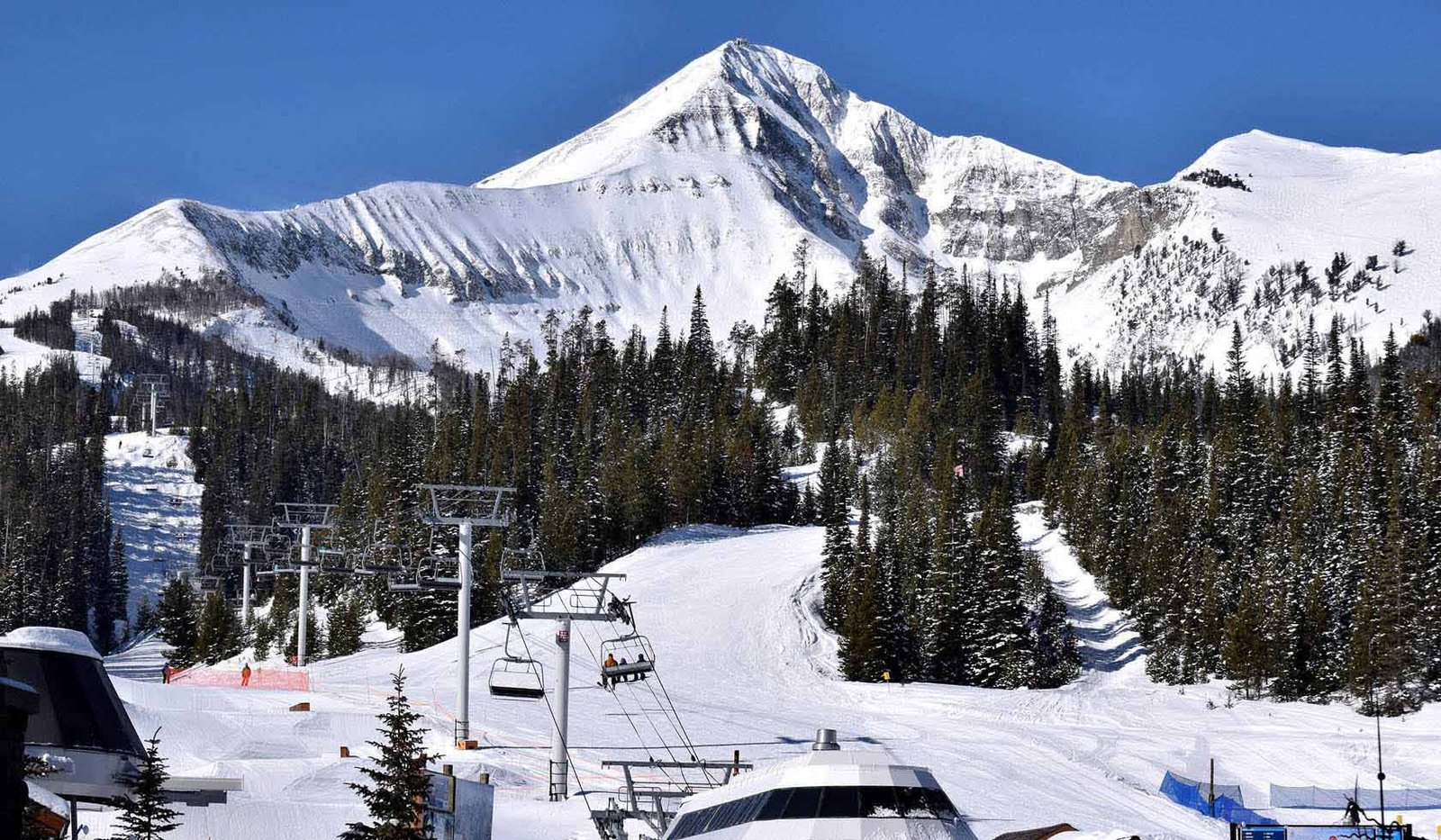
Amazement
- Lone Peak Tram: Takes you to the summit for incredible views and expert runs.
- Low Crowds: Offers a more peaceful skiing experience than busier resorts.
- Yellowstone Access: A nearby natural wonder to explore off the slopes.
Pro Tips:
- Stay Near the Tram: It grants quick access to Lone Peak’s terrain.
- Take Ski Clinics: Great for beginners and intermediates.
- Explore Yellowstone: It’s only an hour away for added adventure.
Precautions:
- Check Weather Reports: High winds can affect Lone Peak.
- Bring Layered Clothing: Temperatures can drop quickly.
- Use Lift Maps: The resort is vast, so plan your routes.
9. Zermatt, Switzerland
- Total Skiable Terrain: 360 km
- Runs: 145
- Lifts: 54
- Average Snowfall: 5 meters
Zermatt’s luxury accommodations and pristine slopes are famous for views of the Matterhorn. It was not until the 19th century that the Swiss village of Zermatt became a skiing destination, though it initially attracted mountaineers who sought to conquer the Matterhorn.
The first ski lift was introduced in 1928, and by the mid-20th century, Zermatt had been advanced and had grown to become one of the most iconic resorts in the world. Its extension towards Cervinia, Italy, only added to its allure as an international destination.
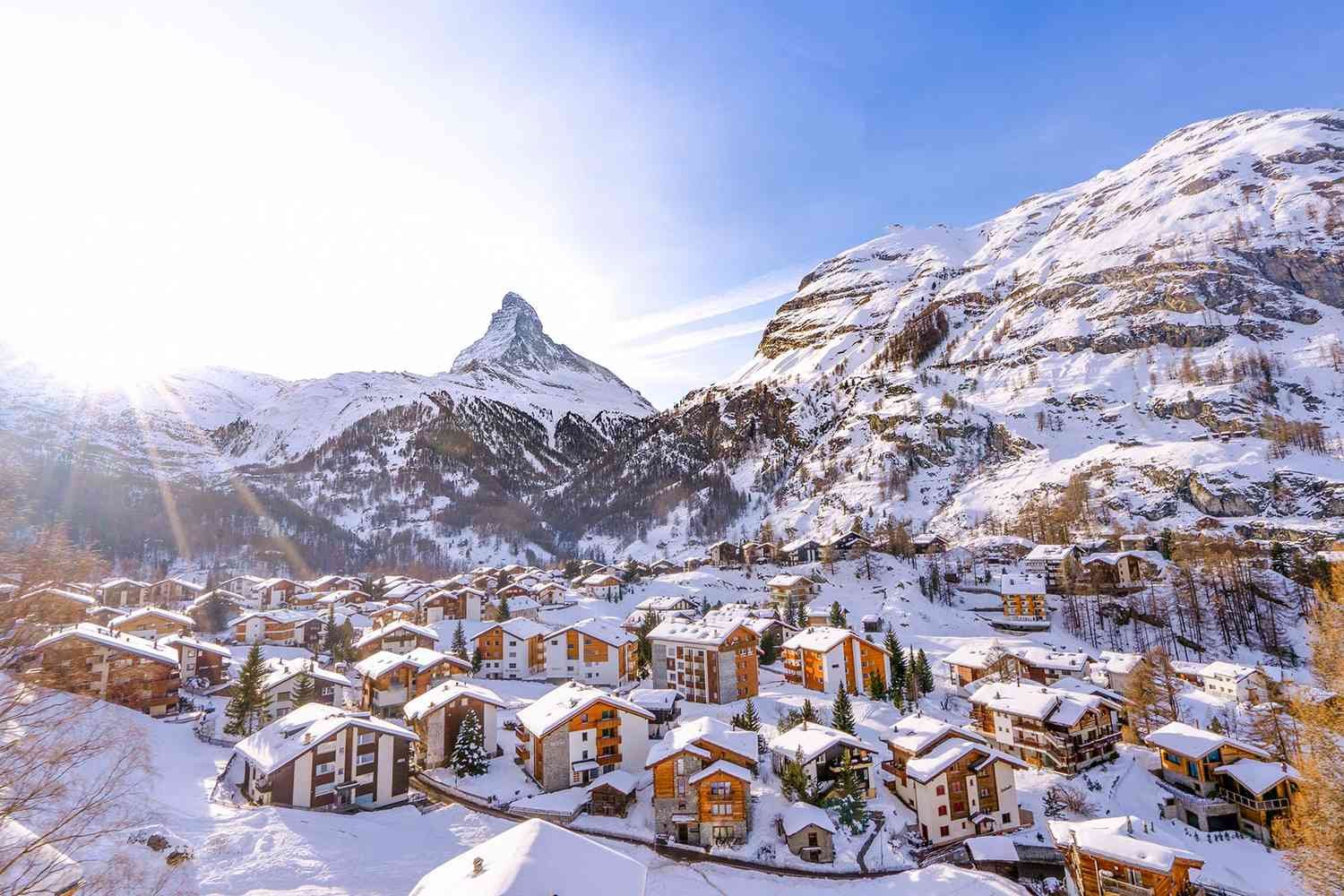
Amazement
- Matterhorn Views: The iconic peak dominates the landscape.
- Car-Free Village: Zermatt’s charm is preserved with no motor vehicles.
- Luxury Experiences: Renowned for high-end accommodations and gourmet dining.
Pro Tips:
- Ski Across Borders: Venture into Cervinia, Italy, for a unique experience.
- Book a Private Lesson: Zermatt’s instructors are world-class.
- Explore Après-Ski: The nightlife is lively and sophisticated.
Precautions:
- Prepare for Altitude: Take breaks to avoid altitude sickness.
- Stick to Trails: Weather can make off-piste areas dangerous.
- Carry Cash: Not all mountain restaurants accept cards.
10. Shiga Kogen, Japan
- Total Skiable Terrain: 425 hectares
- Runs: 79
- Lifts: 53
- Average Snowfall: 10 meters
Shiga Kogen is Japan’s largest ski area; it is known for its dry powder and peaceful nature. The Japan’s largest ski area, began development in the post-WWII period when skiing had become popular as a sporting activity.
The region became an international name when it hosted some events for the 1998 Winter Olympics in neighboring Nagano. It continues to be a premium destination due to its dry powder snow and unique cultural experiences.
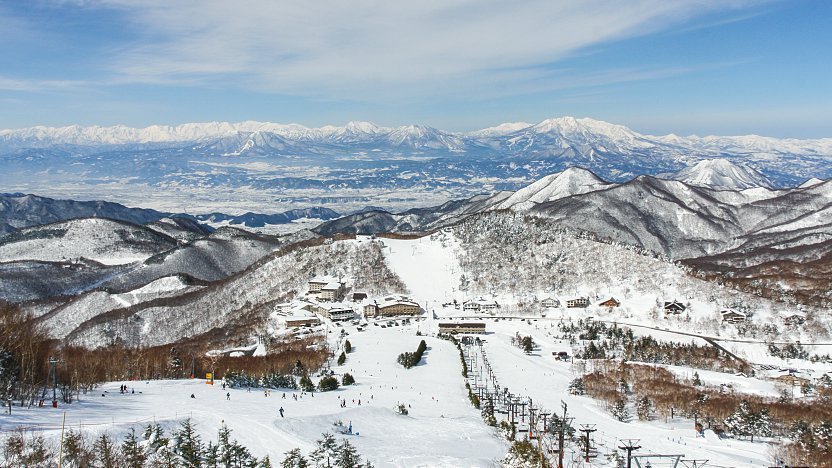
Amazement
- Night Skiing: Enjoy peaceful runs under the stars.
- Snow Monkeys: Witness monkeys bathing in nearby hot springs.
- Onsen Culture: Relax in traditional Japanese hot springs.
Pro Tips:
- Try Night Skiing: The illuminated runs are magical.
- Relax in Onsens: Nearby hot springs offer relaxation after a day of skiing.
- Visit the Snow Monkeys: A unique and unforgettable attraction.
Precautions:
- Bring Waterproof Gear: Snow can be heavy and wet.
- Learn Basic Phrases: English is not widely spoken.
- Follow Resort Rules: Japan has strict skiing etiquette.
Conclusion: The Largest Ski Resorts in the World Are Ideal for Family Skiing Adventures
The biggest ski resorts in the world are more than just huge tracts of snow; they are centers of innovation, adventure, and culture. Each location offers a different experience for skiers and snowboarders with different levels of skill, from the beautiful slopes of Les 3 Vallées in France to the culturally rich Dolomiti Superski in Italy.
Adding the practical tips and preventive steps covered here, a traveler can ensure maximum safety and enjoyment while on the slopes. Whichever your reason for skiing may be-from adrenaline-pumping fun to family activities or finding a serene retreat-these ski resorts promise an unforgettable winter getaway.
Start planning your next ski adventure and embrace the magic of the world’s greatest snow-covered landscapes!